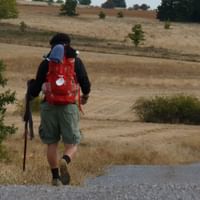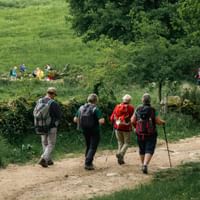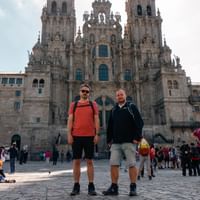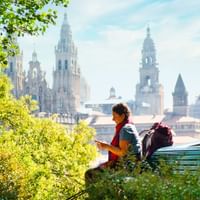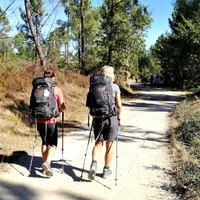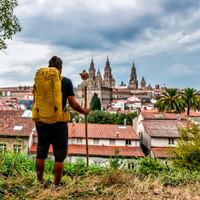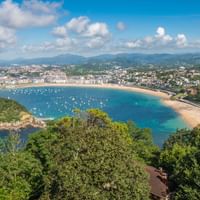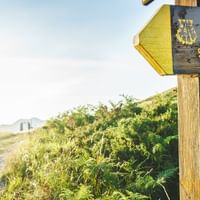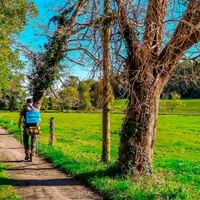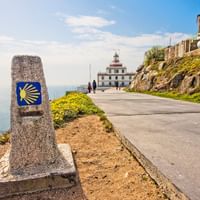Our tours on the Camino
Our tours on the Camino
Bering Travel arranges all the most popular walks along the Camino to Santiago de Compostella. On this page you can see all the tours.
You're probably reading this because you're thinking about walking the Camino and I can certainly understand why. There's something almost magical about walking the route that pilgrims have walked for centuries and it's a tantalising thought that here, right here, another adventurous pilgrim has walked, seen the same, thought the same and had the same sore feet at night.
The Camino is many things. There are the many different routes, which I describe in more detail below, but there is also the inner Camino - the inner journey you go through as you walk day after day with the goal of reaching Santiago de Compostela.
Which Camino should I choose?
Most pilgrims who walk the Camino walk the last 100km of ‘The French Way’, which is from Sarria til Santiago de Compostela. The route offers easy walking for most people to enjoy. Almost as many people choose to walk ‘The Portuguese Way’, which goes from Porto til Santiago de Compostela. The latter walk along the Camino is a two-week trek vandreferie, so many people choose to only do the last part of the journey from Baiona to Santiago de Compostela. Both versions are a great experience.

Camino Francés – The French route – French Way
Camino Francés is arguably the most famous of the Camino routes and has been featured in countless documentaries and books. The Camino is an ancient pilgrimage route along the northern part of the Iberian Peninsula. The route starts in the red and white city of Saint-Jean-Pied-de-Port and ends in the holy city of Santiago de Compostela.
The Camino Frances passes through fantastic cities and beautiful landscapes, such as the city of Pamplona, famous for the bull run, the famous wine region La Rioja with the city of Legroño, the city of Burgos with its beautiful cathedral, elegant Leon and Ponferrada with the old Templar castle. From Ponferrada, the Camino enters Galicia through the mountains and the picturesque town of O Cebreiro.
The Camino is internationally recognised as a historical symbol of European cohesion and in 1987 the route was chosen by the Council of Europe as the first ‘European Cultural Route’. The Camino and the buildings along the route are also a UNESCO World Heritage Site.
Although the route from Saint-Jean-Pied-de-Port is very popular, most pilgrims only walk the last part of the route from Sarria to Santiago de Compostela. This is mainly because you need to have walked a minimum of 100km on the Camion (and stamped your pilgrim passport on the way!) to get your pilgrimage certificate in Santiago. This is also one of the most sociable parts of the Camion because you often meet other pilgrims at the tourist offices in the cities and get chatting. There is simply a special camaraderie among pilgrims on the Camino.
If you're travelling by bike, you need to have covered at least 200km to get your pilgrimage certificate and you need to start your trip from Ponferrada.

Camino Portugues – The Portuguese Camino – The Portuguese Way
The coastal version of The Portuguese Camino is an incredibly beautiful alternative to the traditional Camino Frances. With the Atlantic Ocean as your companion, this route starts in Porto (itself a UNESCO-listed city) and takes you through charming fishing villages in northern Portugal, such as Viana do Castello and Vila Praia de Ancora before crossing the Minho River to A Guarda in Spanish Galicia.
After entering Galicia, you'll wander into the heart of Rías Baixas, where the famous Albariñho white wines are created. From Baiona to Vigo you can enjoy views of the bay and if you want a rest day on the route, we recommend taking it in Vigo to visit the beautiful Cies Islands.
You'll eventually reach Redondela, from where you head inland and join the original Camino Portugues and from here you'll start to meet more and more pilgrims on the same route to Santiago de Compostela.
It takes approximately two weeks to complete the Portuguese Camino from Porto to Santiago, or one week if you cycle the Portuguese Camino.
If you only have a week to hike, you can take the shortened route where you walk the last 100km of the Portuguese Camino from Baiona to Santiago.
Along the route, you'll experience the beautiful Atlantic Ocean, the beautiful beaches of northern Portugal and Galicia, taste amazing fish dishes and wine, stay overnight in small fishing villages and fall in love with the beautiful landscape.

Camino del Norte – The Northern Way
This tour goes from San Sebastian to Santiago. The route follows the north coast of Spain from the Basque Country, through Cantabria, Asturias and finally to Ribadeo in Galicia. From Ribadeo, the route heads inland through forests and across fields to Santiago de Compostela. It is possible to take an alternative route leaving the coast at Oviedo, where Camino del Norte meets the Camino Primitivo, which then follows the rest of the route.
The Camino del Norte starts in the delightful town of San Sabastián, where there are many things to discover - especially if you want to explore Spanish gastronomy - there are many Michelin-starred restaurants in the town. As most of the route follows the coastline, you'll discover charming little fishing villages, swim at beautiful beaches and savour all kinds of fish dishes.
Get inspired at the Guggenheim Museum in Bilbao, stroll past the Royal Palace in Santander, taste Asturias' famous apple cider and travel back in time in Mondoñedo - the ancient royal seat of Galicia.
The Camino del Norte is one of the more challenging Camino routes and we recommend it for experienced walkers and good health.

Camino Primitivo – The original Camino
This is in fact the oldest Camino route. King Alfonso II the Chaste was the first pilgrim ever to walk this route. He walked from Oviedo in Asturias to Santiago in the 8th century. He had a single mission, which was to confirm that it was indeed the remains of St James that lay in Santiago de Compostela.
At the time, Oviedo was the capital of the Kingdom of Asturias and the king's pilgrimage inspired many others to make the same journey to Santiago de Compostela.
Pilgrims on the Camino Primitivo came not only from Asturias and other parts of northern Spain. Pilgrims also came from other parts of the world.
When the capital of the kingdom changed from Oviedo to Leon, the Camino Frances became the main route to Santiago for 11th century pilgrims. That said, many pilgrims still choose to visit the Cathedral of San Salvador in Oviedo, which is its own sanctuary and is said to house the cloth that was wrapped around Christ's head after his death.
Less than five per cent of today's pilgrims choose to walk the Camino Primitivo, but that doesn't change the fact that the route is tough and incredibly beautiful.

Camino Finisterre
Finisterre (Fisterra in Galician) is located on the Atlantic coast about 100km from Santiago de Compostela. Cape Finisterre and the lighthouse have been a destination for pilgrims for centuries.
It was the Romans who named the city ‘Finis Terrae’, meaning end of the world, and they considered it the westernmost point of the Roman Empire. After the discovery of St James' tomb in the Middle Ages, pilgrims began flocking to Finisterre to worship the image of the Sacred Christ and to see the end of the world.
Since then, many pilgrims have taken the route there after reaching Santiago and it is still common for pilgrims to burn their clothes or walking shoes at Cape Finisterre while enjoying the view of the Atlantic Ocean. It's almost a purification ritual or perhaps just a symbolic end to their journey.
Either way, the sunset from the lighthouse is stunning.
The end of the world on the mythical Costa da Morte (Coast of Death) is also considered by some to have housed the Ara Solis, which was/is an ancient altar used to worship the sun. Some say it was treasured by the Phoenicians, others say it was Celtic tribes. It is also at this place that ancient societies (before Christianity) believed that the world of the living and the world of the dead met.
There are plenty of myths and legends to explore at Camino Finisterre.
Although Camino Finisterre is one of the more challenging parts of the Camino (it's called the ‘Coast of Death’ after all), it's also a beautiful walk.

Pilgrim passport on the Camino
You get your passport stamped in all the towns where you stay overnight and when you have enough stamps, you can get your pilgrimage certificate in Santiago de Compostela. Remember that you must have walked at least 100km on the Camino to get your pilgrimage pass.

The other routes on the Camino
In addition to the routes mentioned above, there are also the following other routes:
- Camino Ingles
- Camino Espiritual
- Camino Invierno
- Via de la Plata
Stay in hotels all the way
In the old days, it was most common to stay in hostels when walking the Camino. Of course, a lot of people still do that, but it has become more common to stay in small hotels instead.
On our travels, we only use small, specially selected hotels where all rooms have their own shower and toilet. We think this is the best way to experience hiking the Camino.
Packing list for the Camino
The Camino is no different from many other walking holidays. Therefore, you can get a good overview of what you should bring on our ‘13 tips for hiking’. Remember that the most important thing is that you have good trekking shoes or hiking boots that you make sure to break in before the trip.
Jubilee year in 2027
A Jubilee Year is something very special on the Camino. You can read more about it on the page ‘2027 is a Jubilee Year in Santiago de Compostela’.
